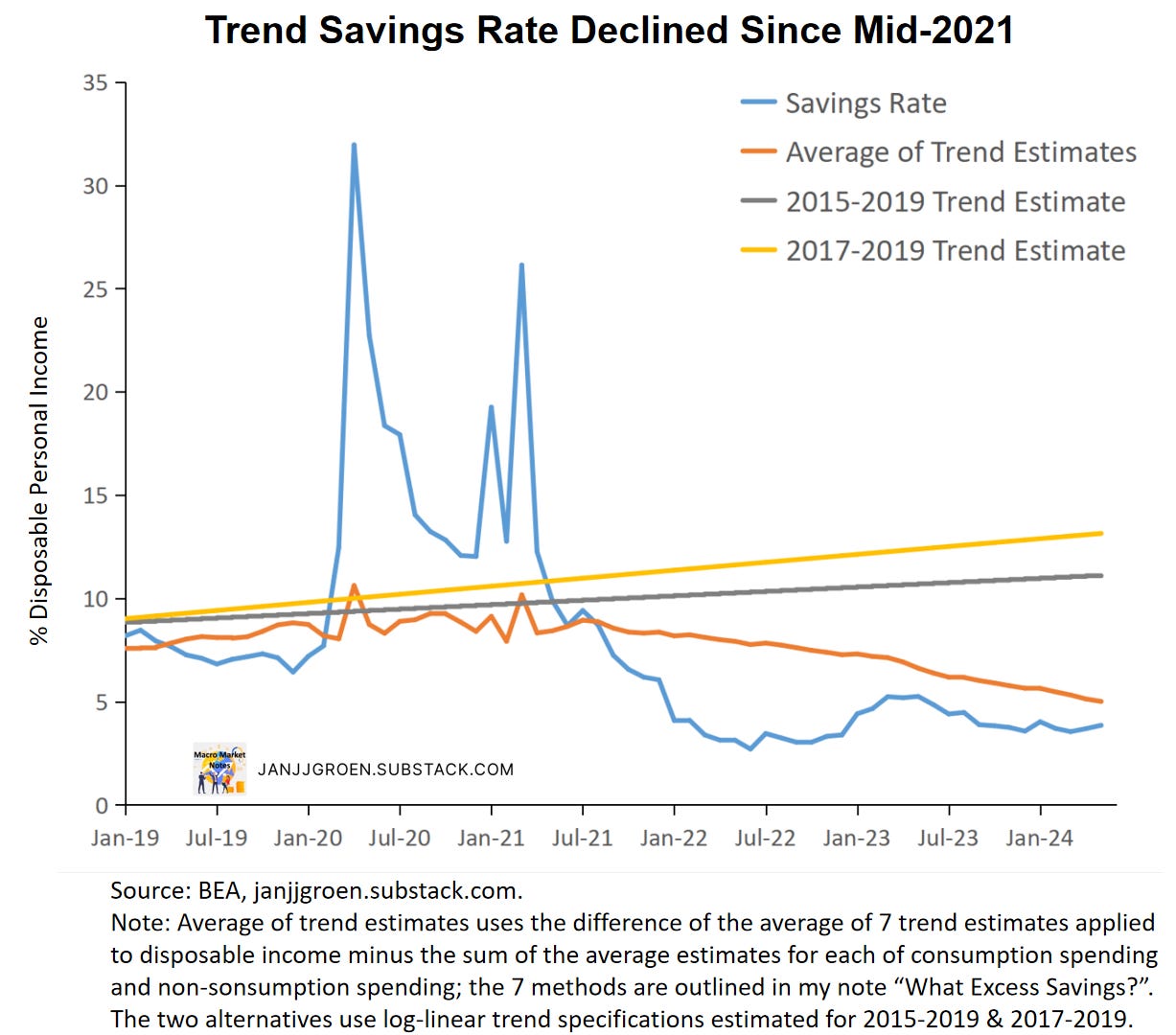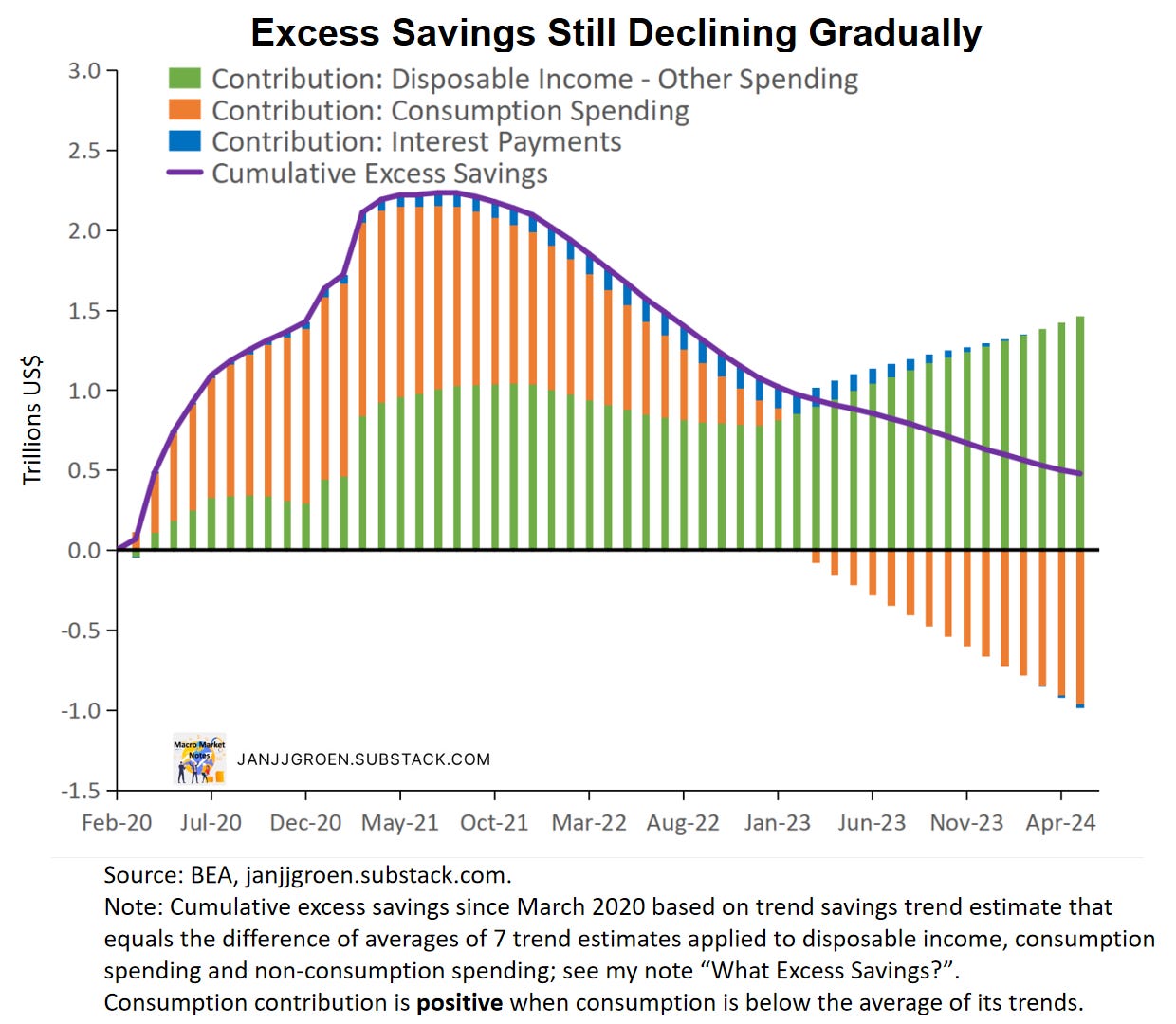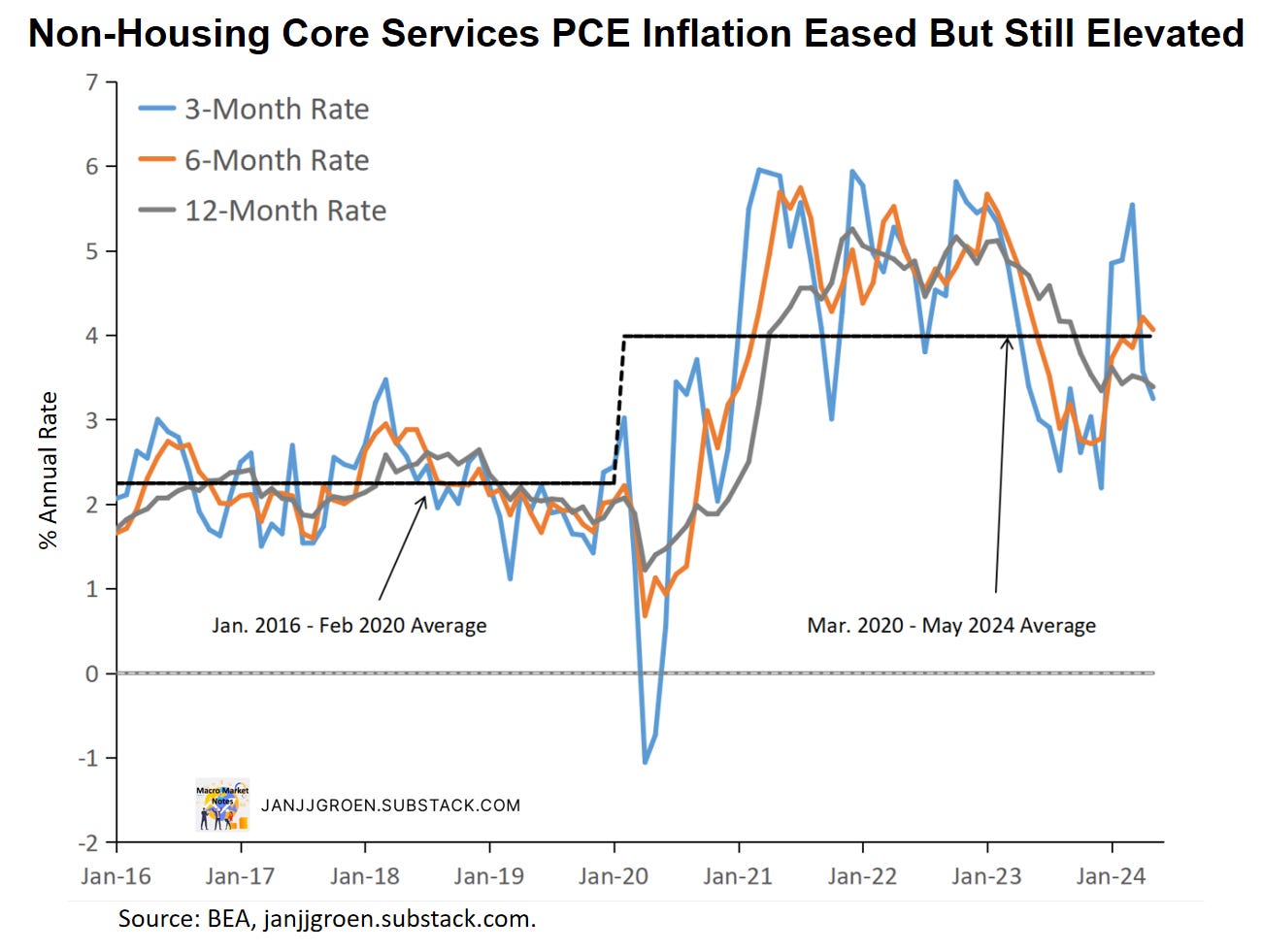May Personal Income & Outlays: Good News
Growth of personal wage income picked up again. Core services and central tendency inflation rates eased but still remain above the 2% target.
The May Personal Income and Outlays report provides a good insight on the U.S. consumer as well as inflationary pressures going forward. This note presents some of these insights.
Key takeaways:
Personal income growth out of wages and salaries picked up in May. This meant that household wage income growth runs slightly above the pace that’s broadly consistent with 2% PCE inflation over the medium-term.
The stock of excess savings has NOT run out and continues to be a tailwind for consumption. Between April and May, it fell around $22 billion and equaled about $477 billion in May.
Going into Q2 2024 headline consumption growth accelerated moderately above underlying spending growth and even beyond Q2 the above-2022 pace of underlying consumption growth does not signal that a large downshift in consumption is forthcoming
Core services excl. housing PCE inflation, the Fed’s favorite gauge of underlying inflation, remains at elevated levels but continued to show a slowing in momentum. The central tendency of PCE inflation currently suggests underlying inflation at around 2.8%.
Although underlying inflation still remains above the 2% inflation target, momentum in these measures is slowing such that it makes a September rate cut possible. But strong wage income and underlying consumption growth rates suggests that the Fed will likely be patient and prefers to start rate cutting towards the backend of the year.
Wage Income Growth Picked Up
A dominant source of household income is personal income out of wages and salaries. Today’s report showed essentially no revisions in growth of household income out of wages and salaries for the recent months (chart below).
The year/year growth rate in May picked compared to April (chart above), as it went up to 4.5% from 4.2% (broadly unrevised). Note that overall personal income growth increased in May from 4.4% to 4.6% year/year, implying that its growth was almost entirely driven by wage income growth in May.
To interpret wage income growth trends, I earlier proposed to compare wage income growth with a neutral benchmark growth rate based on trend non-farm business sector (NFB) output growth and either the abovementioned common inflation expectations factor or the 2% Fed inflation target. Similar to what I did when discussing wages and inflation expectations in my October update, I now also incorporate trend labor share growth into this neutral benchmark.
Any deviation in actual household wage income growth above or below the aforementioned the inflation target-consistent neutral benchmark means household wage income growth outpaces or cannot sustain in the medium term the 2% inflation target.
The chart above shows that with the pickup in wage income growth in May, the wage income growth gap based on the Fed’s inflation target become somewhat more positive and in line with 2.3%-2.5% PCE inflation over the medium term. Nominal wage income growth thus remains broadly consistent with a pace that should be able to bring inflation close to target in the medium term.
Pace of Excess Savings Drawdowns Remains Gradual
Household spending was up 0.2% over the month in May, whereas disposable household income grew 0.5% for the same period. As a consequence, the savings rate moved up from 3.7% in April (upwardly revised from 3.6%) to 3.9%.
The chart above shows that the savings rate remains below my trend savings rate estimate of 5% (down from an unchanged 5.1% in April) using the ‘average of trend’ approach outlined in my earlier excess savings note (orange line). However, for the first time since May 2023 the actual savings rate has been converging back up to this trend savings rate estimate since March of this year. Both remain below trend savings rate assumptions used elsewhere (grey and yellow lines).
Given the earlier discussed pickup in personal wage income growth and savings rate developments, in May cumulative excess savings declined from $499 billion in the previous month (revised down from $523 billion) to about $477 billion (see chart above).
Above-trend growth in disposable income continues to be a partial offset to the drawdowns in excess savings coming from above-trend growth in consumption spending and interest payments.
Underlying Consumption Growth Remains Strong
As is the case with headline inflation, headline real consumption spending growth often is driven by volatile components that not always reflect the underlying strength of the economy. A core real consumption spending growth measure, therefore, would be really useful, and I do that by approximating such a core measure based on the weighted median across 177 components1 of headline real personal consumption expenditures (PCE). More specifically, the core, or underlying, consumption growth measure equals the growth rate of the real PCE component at the 50% percentile across growth rates of these 177 sub-components of headline real PCE.
The chart above focuses on three-month annualized consumption growth rates. After accelerating notably during most of 2023, underlying (or core) consumption growth decelerated and stabilized around a 1.5% annualized 3-month rate, higher than the 1% pace observed for 2022. Headline consumption growth overshot the underlying rate by the end of 2023 and the subsequent weakening in real headline spending during Q1 2024 was the consequence of a correction back towards underlying spending growth.
Going into Q2 2024 headline consumption growth accelerated moderately above underlying spending growth again. This suggests strong household spending in Q2 and even beyond Q2 the above-2022 pace of underlying consumption growth does not signal that a large downshift in consumption is forthcoming.
Underlying Inflation Rates Eased but Remain Above 2%
In terms of inflation, core PCE inflation slowed in May to about an 1% annualized monthly rate from an upwardly revised 3.2% rate in April. Core goods inflation sharply decelerated to -2.2% annualized month/month from +1.3% in April, whereas core service inflation eased up to 2.1% annualized month/month in April from an upwardly revised 3.8% in the preceding month.
The Fed’s favorite gauge of underlying inflation, core services excl. housing PCE inflation again, as in April, drove a lot of the core service inflation deceleration in May, as its pace slowed from (an upwardly revised) 3.4% annualized month/month to about 1.2%. Given the large volatility in this measure since late 2023 it seems worthwhile to smooth through noisy month-over-month dynamics.
The chart above plots three-, six- and 12-month annualized inflation rates for the non-housing core services PCE deflator. The average annualized monthly rate still reads about 4% for the post-COVID era (black dashed line), two times the average rate we observed for the immediate years pre-COVID.
The momentum measures in the chart above have been sticky around 4% for most of 2023. But in Q4 2023 momentum in core services excl. housing PCE inflation appeared to ease in a tentative sign that it might finally start to break free from the post-pandemic 4% trend. However, this disinflationary trend reversed in Q1 2024. Since April, momentum in this non-housing core services inflation measure slowed again, but its rate remains still quite elevated compared to pre-2020 averages.
Instead of focusing on whether specific components of inflation should be ignored or not when assessing underlying inflation trends, one could focus on the central tendency of consumer price inflation, a.k.a. the center of the distribution of all price changes unaffected by extremely volatile consumer price components. This could potentially provide a better sense of the target toward which inflation moves over time once those excessively volatile price changes have stabilized.
Such measures of central tendency for the PCE price indices use a variety of trimming procedures to weed out excessive volatile components of these price indices in a given month:
Median CPI, which takes the inflation rate of the component at the 50% percentile of the CPI component price changes.
Trimmed Mean PCE (Dallas Fed), where the highest 31% and lowest 24% of PCE component price changes are dropped.
15% Trimmed Mean PCE, where the highest 7.5% and lowest 7.5% of PCE component price changes are dropped.
20% Trimmed Mean PCE, where the highest 10% and lowest 10% of PCE component price changes are dropped.
30% Trimmed Mean PCE, where the highest 15% and lowest 15% of PCE component price changes are dropped.
The chart above scales each of these measures into a three-month average distance relative to 2% core PCE inflation as a measure of the Fed's inflation target. Based on these three-month averages underlying inflation essentially was in line with the 2% inflation target by December 20233. That all changed in Q1 2024 with underlying three-month inflation rates sharply overshooting the Fed's inflation target. But since April this overshoot eased notably with the three-month deviations dropping below 0.5 percentage point in May.
Alternatively, it might be more insightful to look at the smoother six-month averages of the annualized percentage point deviation of monthly central tendency inflation measures relative to their values as implied by 2% core PCE inflation. This is also consistent with recent public statements by Fed officials that they’d like to see sustained progress of inflation converging back to target. For example, the newly minted St. Louis Fed President Alberto Musalem suggested it "[...] could take months, and more likely quarters [...]" of inflation progress before he'd be comfortable with policy easing. I suspect a lot of Fed officials would be happy to start cutting the Fed funds rate if the annualized six-month reading on underlying core PCE inflation would hit 2.5% or less.
The chart above suggests a qualitatively similar story as for the three-month average measures: a lot of progress was made by the end 2023 in terms of a return back towards the Fed’s 2% inflation target, which since late 2023 reversed, but easing came back on the table again since April.
The six-month average deviations of underlying PCE inflation rates relative to the inflation target in the chart above suggest that we have currently an underlying PCE inflation trend of around 2.8%. Given where underlying inflation rates are a three-month average basis, it is possible further slowing over the summer could push the underlying PCE inflation trend to around 2.5% by the time of the July Personal Income & Outlays report.
Given the momentum in underlying inflation rates it is possible that by the time of the September FOMC meeting Fed officials have seen enough of a sustained progress on inflation to be comfortable with commencing rate cuts. However, given strong underlying spending growth it seems rate cuts will be more likely towards the backend of the year. Only a deterioration beyond the cooling in growth and unemployment projected in the June SEP would force the FOMC's hand to start rate cuts earlier.
For a description of these 177 components, see Appendix A in the Dallas Fed trimmed mean PCE inflation working paper, where I use the corresponding real quantities instead of the price indices.











